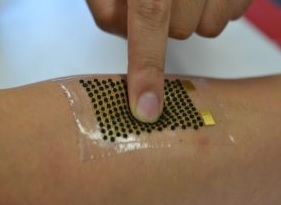
The biofuel cells use energy from sweat to generate 10 times more power per surface area than other biofuel cells that are used in wearables. The researchers claim it could be used to power a variety of wearable devices.
Using lithography and screen printing, engineers created a stretchable electronic foundation that was a 3D carbon nanotube-based cathode and anode arrays.
The epidermal biofuel cells have an enzyme that can oxidize the lactic acid in sweat and use that to generate electricity. The researchers were able to test the fuel cell and power an LED light while a person wore it during exercise.
To make the biofuel cells compatible with wearable devices, the team of engineers, led by the director of the Center for Wearable Sensors at UC San Diego Joseph Wang, used a bridge and island structure to make the biofuel cells flexible and stretchable. The structure consists of rows of dots that are connected by spring-shaped structures. Half of the dots are anode, and the other half are cathode. The spring-like structures between the dots are able to stretch and bend without breaking or deforming the anode and cathode.
The islands and bridges were made using lithography and are made of gold. The researchers then used screen printing to put layers of biofuel materials on top of anode and cathode dots.
The engineers on the project were then challenged with determining how much energy the biofuel cell could create per surface area. The more energy generated, the more powerful they cells can be.
“We needed to figure out the best combination of materials to use and in what ratio to use them,” Amy Bandodkar, the paper’s first author, said in a
press release.
Engineers screen printed a 3D carbon nanostructure on top of the anodes and cathodes to increase power density. Each anodic dot could then be loaded with more of the enzyme and silver oxide at the cathode dots. The tubes could also transfer electrons easier to improve biofuel cell performance.
When the biofuel cell was created, the researchers connected it to a custom-made circuit board that was a DC/DC converter and could even out the power created by the fuel cells. The power generated tends to fluctuate when powered by sweat because the amount of sweat a user produces can vary. The evened out power was turned into constant power with a constant voltage.
Four people wore the biofuel cell-board combination and exercised on a stationary bike. Each of the participants were able to power a blue LED light for four minutes.
Now the researchers plan to find a more stable solution for silver oxide, which tends to degrade over time and is light sensitive. They also plan to find a way to store energy that is produced because sweat becomes diluted over time.
The research was published online in the journal Energy and Environmental Science

